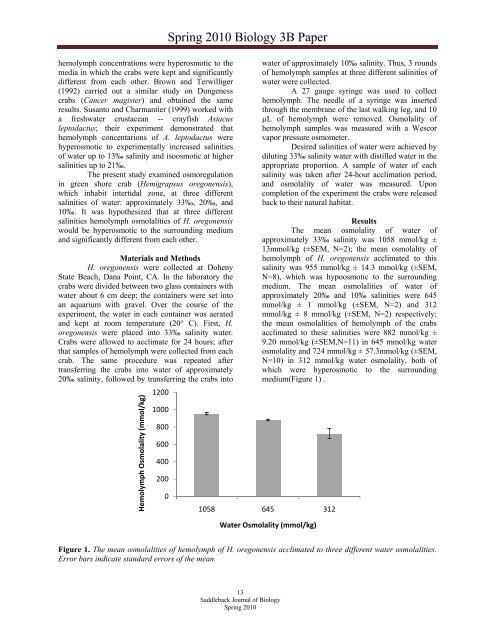Saddleback Journal of Biology - Saddleback College
Saddleback Journal of Biology - Saddleback College
Saddleback Journal of Biology - Saddleback College
You also want an ePaper? Increase the reach of your titles
YUMPU automatically turns print PDFs into web optimized ePapers that Google loves.
hemolymph concentrations were hyperosmotic to the<br />
media in which the crabs were kept and significantly<br />
different from each other. Brown and Terwilliger<br />
(1992) carried out a similar study on Dungeness<br />
crabs (Cancer magister) and obtained the same<br />
results. Susanto and Charmantier (1999) worked with<br />
a freshwater crustacean -- crayfish Astacus<br />
leptodactus; their experiment demonstrated that<br />
hemolymph concentarions <strong>of</strong> A. leptodactus were<br />
hyperosmotic to experimentally increased salinities<br />
<strong>of</strong> water up to 13‰ salinity and isoosmotic at higher<br />
salinities up to 21‰.<br />
The present study examined osmoregulation<br />
in green shore crab (Hemigrapsus oregonensis),<br />
which inhabit intertidal zone, at three different<br />
salinities <strong>of</strong> water: approximately 33‰, 20‰, and<br />
10‰. It was hypothesized that at three different<br />
salinities hemolymph osmolalities <strong>of</strong> H. oregonensis<br />
would be hyperosmotic to the surrounding medium<br />
and significantly different from each other.<br />
Materials and Methods<br />
H. oregonensis were collected at Doheny<br />
State Beach, Dana Point, CA. In the laboratory the<br />
crabs were divided between two glass containers with<br />
water about 6 cm deep; the containers were set into<br />
an aquarium with gravel. Over the course <strong>of</strong> the<br />
experiment, the water in each container was aerated<br />
and kept at room temperature (20° C). First, H.<br />
oregonensis were placed into 33‰ salinity water.<br />
Crabs were allowed to acclimate for 24 hours; after<br />
that samples <strong>of</strong> hemolymph were collected from each<br />
crab. The same procedure was repeated after<br />
transferring the crabs into water <strong>of</strong> approximately<br />
20‰ salinity, followed by transferring the crabs into<br />
Hemolymph Osmolality (mmol/kg)<br />
1200<br />
1000<br />
800<br />
600<br />
400<br />
200<br />
Spring 2010 <strong>Biology</strong> 3B Paper<br />
0<br />
water <strong>of</strong> approximately 10‰ salinity. Thus, 3 rounds<br />
<strong>of</strong> hemolymph samples at three different salinities <strong>of</strong><br />
water were collected.<br />
A 27 gauge syringe was used to collect<br />
hemolymph. The needle <strong>of</strong> a syringe was inserted<br />
through the membrane <strong>of</strong> the last walking leg, and 10<br />
µL <strong>of</strong> hemolymph were removed. Osmolality <strong>of</strong><br />
hemolymph samples was measured with a Wescor<br />
vapor pressure osmometer.<br />
Desired salinities <strong>of</strong> water were achieved by<br />
diluting 33‰ salinity water with distilled water in the<br />
appropriate proportion. A sample <strong>of</strong> water <strong>of</strong> each<br />
salinity was taken after 24-hour acclimation period,<br />
and osmolality <strong>of</strong> water was measured. Upon<br />
completion <strong>of</strong> the experiment the crabs were released<br />
back to their natural habitat.<br />
Results<br />
The mean osmolality <strong>of</strong> water <strong>of</strong><br />
approximately 33‰ salinity was 1058 mmol/kg ±<br />
13mmol/kg (±SEM, N=2); the mean osmolality <strong>of</strong><br />
hemolymph <strong>of</strong> H. oregonensis acclimated to this<br />
salinity was 955 mmol/kg ± 14.3 mmol/kg (±SEM,<br />
N=8), which was hypoosmotic to the surrounding<br />
medium. The mean osmolalities <strong>of</strong> water <strong>of</strong><br />
approximately 20‰ and 10‰ salinities were 645<br />
mmol/kg ± 1 mmol/kg (±SEM, N=2) and 312<br />
mmol/kg ± 8 mmol/kg (±SEM, N=2) respectively;<br />
the mean osmolalities <strong>of</strong> hemolymph <strong>of</strong> the crabs<br />
acclimated to these salinities were 882 mmol/kg ±<br />
9.20 mmol/kg (±SEM,N=11) in 645 mmol/kg water<br />
osmolality and 724 mmol/kg ± 57.3mmol/kg (±SEM,<br />
N=10) in 312 mmol/kg water osmolality, both <strong>of</strong><br />
which were hyperosmotic to the surrounding<br />
medium(Figure 1) .<br />
1058 645 312<br />
Water Osmolality (mmol/kg)<br />
Figure 1. The mean osmolalities <strong>of</strong> hemolymph <strong>of</strong> H. oregonensis acclimated to three different water osmolalities.<br />
Error bars indicate standard errors <strong>of</strong> the mean.<br />
13<br />
<strong>Saddleback</strong> <strong>Journal</strong> <strong>of</strong> <strong>Biology</strong><br />
Spring 2010

















